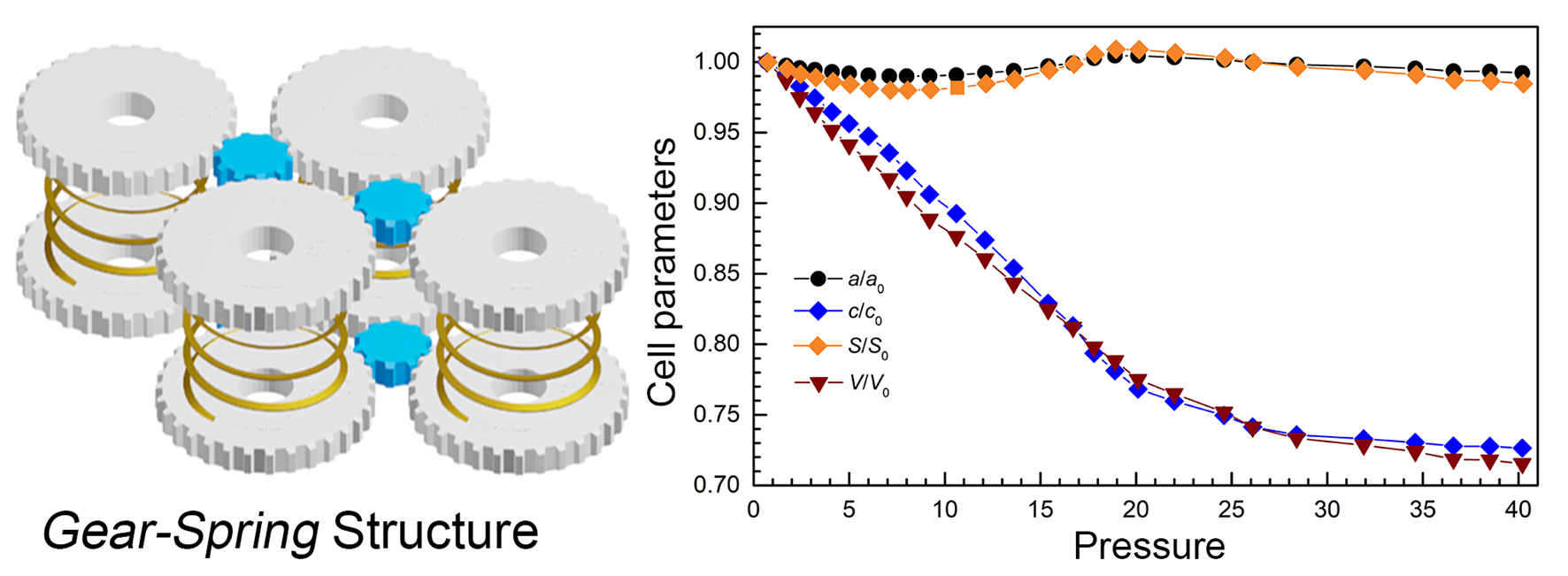A 'Gear-Spring' structure with anomalous compressibility – Drs. Ting Wen and Yonggang Wang
JANUARY 18, 2022
Materials with zero-linear compression (ZLC) and zero-area compression (ZAC) hold great promises for specific applications retaining constant in specific directions or planes under external impaction. Up to now, no more than ten ZLC/ZAC materials have been reported, most of which are of very limited working pressure ranges (< 10 GPa). Herein, a pioneering work led by Dr. Ting Wen and Dr. Yonggang Wang from HPSTAR reports their discovery of an intrinsic ZLC/ZAC property in Li2Ti(IO3)6 with a new “Gear-Spring” type structure over an ultra-wide pressure range (up to 40 GPa). The results have been published online in recent CCS Chemistry.
Substances normally contract under external hydrostatic pressure, just as they expand with heat and contract with cold. Nevertheless, there are several types of materials possessing abnormal compressibility in specific crystalline directions or planes. Zero linear compressibility (ZLC) and zero area compressibility (ZAC) can be easily achieved by finding a balance between negative and positive compressibility, and the linear/area compressibility of diamond are used as standard to classify a ZLC/ZAC material. ZLC/ZAC materials are ideal candidates for precision instruments applied under extreme environments. Surprisingly, material with ZLC/ZAC has been rarely discovered. Meanwhile, there lacks clear structure-property mechanism for the rational design of ZLC/ZAC materials.
All-inorganic frameworks possessing covalently-bonded frameworks are less compressible. In addition, all-inorganic frameworks can have good chemical/physical stability and excellent optical performances. Therefore, the research team screened numerous known inorganic compounds in the ICSD database and focused on a unique family of transition metal iodates with metal-metal bonding and chains for ZLC/ZAC behavior. Li2Ti(IO3)6 was obtained for the furhter investigation.

Caption: The "Gear-Spring" type structure and Cell parameters and volume as functions of pressure.
In-situ high-pressure XRD measurements pointed out that the (hk0) peaks basically keep their 2θ values unchanged, indicating an incompressibility or minimal compressibility along the a and b axes. The small overall change of the a axis (Δa) and area change of the ab plane (Δs) proved that Li2Ti(IO3)6 exihibited the ZLC/ZAC property. Moreover, it sets a record-wide ZLC/ZAC working pressure range (up to 40 GPa).
A “Gear-Spring” type structure can well explain the ZLC/ZAC mechanism. As rigid “gears”, the sizes of “Gear-A”and“Gear-B” should basically remain unchanged. In the meantime, the spring length (c) decearses rapidly along with the increasing of applied pressure, working together as real springs.
"The demonstration of intrinsic and long-lasting ZLC/ZAC with a gear-spring mechanism allows shock-resistant precision optics to be applied under extreme conditions,” said by Dr. Wen.
具有零线性压缩(ZLC)和零面积压缩(ZAC)的材料对于在特定方向或平面上外部冲击下保持恒定的特定应用具有很大的前景。目前为止,已报道的具有零线性或零面积压缩性质的材料总共不超过十种,其中大部分的工作压力局限在小于10 GPa的低压范围内。近日,北京高压科学研究中心的温婷博士和王永刚研究员课题组研究发现了具有“齿轮-弹簧”型结构的 Li2Ti(IO3)6 在超宽压力范围(高达 40 GPa)内都具有内秉的零线性压缩和零面积压缩性质。晶体结构分析表明,在这个独特的“齿轮-弹簧”型结构中刚性齿轮的受力转动与弹性弹簧的压缩协同作用产生持续的零线性和零面积效果。相关研究成果以“Intrinsic Zero-Linear and Zero-Area Compressibility over an Ultra-Wide Pressure Range within a Gear-Spring Structure”为题发表在中国化学会旗舰期刊《CCS Chemistry》上。
